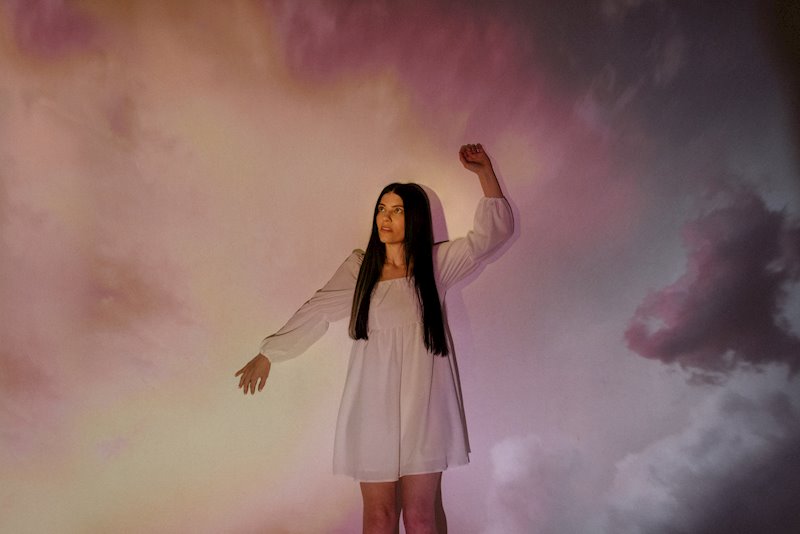One day, while in her small town in central California, teenage Emily Whitehurst’s interest in music switched from “Off” to “On” after hearing a particular band. “I didn’t have aspirations of being a singer or a musician,” Emily tells Post-Burnout. “How much I loved Green Day is what inspired me to be part of music. I loved it so much that I felt like, ‘I want to do this. I can do this.’ And it wasn’t even like, ‘I want to do this forever. I want to do it professionally;’ it was more just, ‘I feel so energised by this music that I feel like I want to make my own in the same vein and just be part of this whole thing.’”
Emily soon began forming projects to facilitate this new pop-punk vigour that she had. She says, “I started when I was in high school, and there was absolutely no music scene in my town – because I grew up in a really small town – so, it’s not like the stakes were high; [there] wasn’t a lot of competition or anything. It was pretty easy to put together a show in random places, like at parties or a coffee shop, and we would pretty much just play wherever we could, and I did not have a lot of expectations on myself, because, at that point, it was just for fun. And that’s kind of how I continued throughout all of the music that I’ve made, is I’m just kind of seeing how much I can do, how far I can get while trying to improve but I’m not…maybe because I haven’t had any training…I’m not holding a crazy high bar for myself, if that makes sense.”
After high school, Emily moved north to attend Sonoma State University in Rohnert Park, California, and continued making music whilst there. In late 1998, she was offered and accepted an invitation to join a nearby punk band called Tsunami Bomb, who were making waves in their local scene and were looking for a new singer. The success of Tsunami Bomb, which enabled them to tour the world, play the Warped Tour, get a record deal, and amass a fanbase, was also marred with in-fighting and continual reshuffling of members. Eventually, the band called it a day in 2005, and, straight away, Emily began her next project, The Action Design, which, in contrast, had much more focus on pop melodies and indie guitar riffs. The band continued until 2011 when it was announced that Emily and her long-time collaborator, Jaycen Mckissick, were to start a new project: Survival Guide.
Survival Guide saw a full transition to more dance-oriented pop music, with Emily seeming to have shredded the residual punk influence in her vocal performance. Originally, Jaycen played guitar, while Emily sang and played keys; however, Jaycen left the band after the birth of his child. As much of a somewhat uncomfortable strip going from a full band to a two-piece already was for Emily, who only saw herself as a vocalist and not an instrumentalist, she decided to keep Survival Guide going as a solo project. “That was a really big goal of mine, to not feel like I had to depend on another musician to continue to create music, because, as time goes on, it’s like people drop off from doing music,” she says. “They reach a point where they feel like they need to be doing something that maybe seems more responsible, I don’t know. [Laughs] So, I’m still a hold-out, you know? I’m like, ‘I’m going to keep going.’”

Courtesy of Reybee
For her next move, Emily actually turned to two platforms which, hitherto, would be unavailable to her just a few years prior: the crowdfunding site Patreon, and the streaming service Twitch. “Patreon and Twitch have really helped me stay a musician,” she says. “I have so much gratitude for the people who have been there with me. They’ve been on this journey for years, for a few years now. I started the Patreon to try and build a small community that would also help me gradually gain the confidence to be able to write my album, and it’s been a long process, but I’m so appreciative of those people who have been there since day one, like, ‘Yes! You can do it! We want more music!’ So, without that, I don’t even know what direction I would have gone.” On Twitch, she says, “Twitch, not only is it a place where people can contribute if they want to, but it’s also been a place where I could continue to build confidence on performing by myself, and I’m just using that platform to get more comfortable with playing piano and playing bass, and just improving myself, technically, as a musician.”
Through Twitch streams, with people finding her at random and sticking around because they like what they hear, Emily finds that Survival Guide is gaining a new fanbase, independent from those who knew her from her previous projects. One of her tiers on Patreon included doing covers of fans’ choices. These requests eventuated into Survival Guide’s Request Hotline series of albums, comprised of covers from The Smiths to The Misfits to Avril Lavigne to David Bowie to Nena. Both of these factors aided Emily in being able to write her first solely-written album, deathdreams, which is released tomorrow.
Speaking on making this album and not having the feedback from other members in the process, Emily says: “I struggled with that a lot when writing this album, because I have never…I mean, that to me is the epitome of what made it so difficult, is that I have always had other musicians to work with and throw ideas back and forth with, and with Survival Guide, and it was a two-piece, that was already like, ‘Oh, wow! We don’t have a drummer? We don’t have…you know, we need to figure out how to do all this ourselves, just being a guitar player and mainly a vocalist and I do whatever I can on keyboards.’ And that is really what was intimidating about deciding to do a whole record myself, is I knew that I would have to trust myself. [Laughs] Which, I…but it did have its pros, as well.
“Like you’re saying, there are some notable things in the album that I did that…there are some decisions that I made that I felt that I would not have even presented to a band because I thought, ‘Oh, they wouldn’t like this idea,’ you know? Or ‘They’ll think this is dumb,’ or just, you know, prejudging my own creative ideas and being a little embarrassed by them and thinking that a more-skilled musician would think that it wasn’t a good idea. So, that was really fun. It was kind of a toss-up. I think having the freedom to do what I wanted did end up being a stronger, positive thing than the negative of not having anyone to confer with because it just…it did exactly what I wanted it to do, and it proved to me that I could do it, because I wasn’t really sure. [Laughs]”
Produced by Bob Hoag (who’s best known for his work with The Ataris) and distributed by Double Helix Records, Emily feels that despite the album’s euphonious, fully-realised pop focus, there are actually some more elements taken from her punk days than on previous Survival Guide releases. “I feel like the thing that I took from punk rock – which is really, specifically, my favourite things from punk rock – is that I feel like it’s necessary to have an interesting vocal melody,” she explains. “So, that is one thing that I will, hopefully, always have. [Laughs] And I, actually, feel like deathdreams, as opposed to Way to Go – which is the last, you know, original Survival Guide record – I feel like I have actually returned a little bit to stronger vocals; like, more fully-loud vocals.
“I was having to do some work with Way to Go recently, and I had to… – you know, I don’t listen to my own music [Laughs] – and I was having to listen to that record, and I thought, ‘Wow, I really was singing very soft on a lot of stuff.’ Like, these are songs that I’m still performing on Twitch all the time, and the album version is so, like, soft. And I consciously decided that I wanted to go back to some more strong vocals. Obviously, not as blasty as Tsunami Bomb was, because that was, like, you know, all energy, all the time, but I do feel like I’ve brought a little bit of that back for deathdreams. But, yeah, I’m not, like, actively or consciously trying to reflect my past projects in Survival Guide or in deathdreams; I am mainly just making music and just seeing what happens. The whole album was just almost like a test. If I can do it, and what comes out of it.”
While she talks about how she would like to someday return to tour Ireland and the UK, for now, Emily’s immediate focus after the album’s release is its accompanying cocktail recipe book. “I’m making a cocktail book, where there’s one recipe for each song,” she says. Currently two songs/recipes shy from a completed book, she adds, “So, that will be a digital recipe book that is a companion for deathdreams. So, that will be a fun project.”
Survival Guide’s latest album, deathdreams, is out tomorrow, and you can get it here. You can follow Survival Guide on Facebook, Twitter, Instagram, Patreon, and Twitch. For a much more extensive version of this interview, where we discuss working with producer Bob Hoag, signing with Double Helix, the album’s music videos, and more, tune into today’s episode of POSTBURNOUT.COM Interviews… at 17:00 (IST) on YouTube, Spotify, Apple Podcasts, and Amazon Music Podcasts.

Aaron Kavanagh is the Founder and Editor-in-Chief of Post-Burnout. His writing can also be found in the Irish Daily Star, Buzz.ie, Totally Dublin, The GOO, Headstuff, New Noise Magazine, XS Noize, DSCVRD and more.

 POST-BURNOUT
POST-BURNOUT